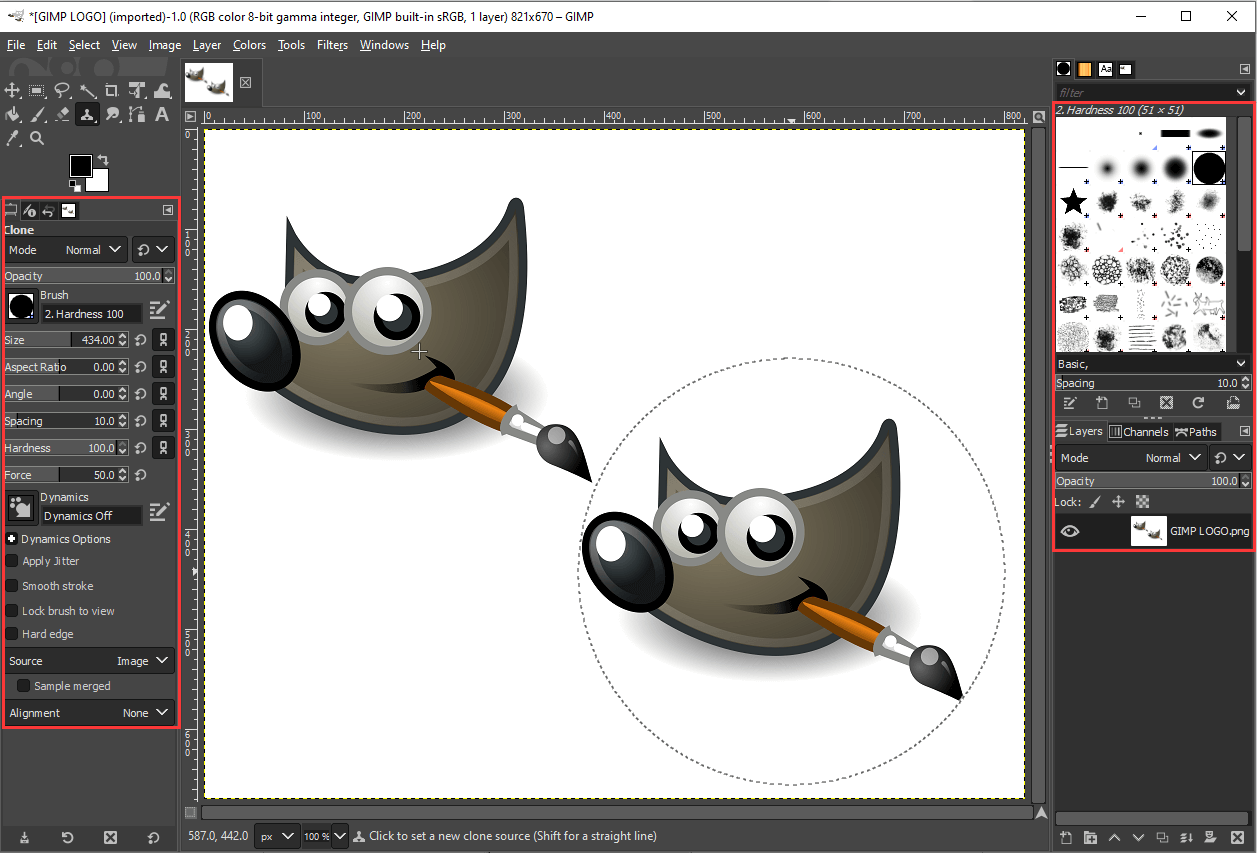This post offered by MiniTool group teaches you how to make use of the GIMP clone tool to copy images, layers, patterns, masks, etc. It also involves in solving GIMP clone tool unavailable problem. Anyhow, you can learn the skill in an easy-to-understand guide.
What Is GIMP Clone Tool?
GIMP, full name GNU Image Manipulation Program, is a free open-source raster photo editor. It is a big competitor to Adobe Photoshop. Since GIMP is completely free and can be customized by users, many people choose to use it instead of Photoshop.
About GIMP Clone Tool
Clone tool GIMP is one of the many useful and popular features within the GIMP program. With it, you can easily and quickly copy an image or pattern from one place to another. The clone tool uses the brush to copy.
Relying on the GIMP clone tool, on the one hand, you can repair problem areas in digital photos by painting them over with pixel data from other good areas. On the other hand, you are able to draw patterned lines or curves.
How to Use Clone Tool in GIMP?
For using clone tool in GIMP, first of all, you need to active it. There are three ways to activate the clone tool.
How to Activate GIMP Clone Tool?
- The simplest way is to press the “c” key on your keyboard when you are in GIMP.
- Also, you can quickly activate the clone tool by clicking the clone stamp GIMP.
- Finally, you can find the GIMP clone tool via Tools > Paint Tools > Clone.
Once you have activated the clone utility, you can make use of it for further operations.
How to Clone Image in GIMP?
The most important key that you usually use while cloning an image is Ctrl.
Step 1. Open both source and target image with GIMP. You can simply drag the source photo into GIMP to open it and create a new image through File > New.
Step 2. Put your mouse cursor (it turns out to be a dotted circle in GIMP) on the source area in the source image, hold the Ctrl key and click once to select the source section. Once selected, the source area will be marked with a dotted circle.
Step 3. Move your cursor to the destination image or target area (it can be somewhere in the source image), click to paste the selected area.

Also read: How to Resize an Image in GIMP? – 2 Methods!
There are some GIMP clone tool options (in the red rectangle areas) for you to specify your clone process.
- Clone Mode: The default mode is normal. You can change to other modes.
- Opacity: By default, opacity is 100, not transparent. You are allowed to change the transparency from 0 to 100 by the up/down arrow or just drag the slide right/left. Note the opacity refers to the transparency of the cloned image.
- GIMP Clone brush: It determines the style of the copied area. You can preview the effect of each brush style in the tool area on the right section of the GIMP screen. You can also edit your selected brush style with size, aspect ratio, angle, spacing, hardness, and force.
- Clone Dynamics: There are some clone dynamic effects for you to choose from and the default one is no dynamic effect. Still, you can edit your selected dynamic effect with opacity, size, angle, color, rate, flow, gitter, spacing, aspect ratio, force, as well as hardness.
- Clone Source: This option is for you to decide which kind of source to clone from, image or pattern. If you choose Pattern as the clone source, there are many built-in patterns available. You can also open patterns as an image in the pattern selection dialog.
- Clone Alignment: Finally, the GIMP clone tool enables you to specify the alignment of your cloned item. There are 4 types of alignment, none, aligned, registered, and fixed.
How to Clone Pattern in GIMP?
The pattern clone process is similar to the image clone. The difference is that you should select a clone source from the patterns provided by GIMP. And, when you paste the selected pattern into the target place, the pattern is tiled.
That is to say, when the point you are copying from moves past one of the edges, it jumps to the opposite edge and continues, seems like the pattern is indefinitely repeated side-by-side.
Related article: How to Crop in GIMP Quickly and Easily?
You can clone from any drawable (layer, layer mask, or channel) to any other drawable. If you are cloning colors that the destination doesn’t support (e.g. cloning from an RGB layer to an Indexed layer or layer mask), the colors will be converted to the closest possible approximations.
GIMP Clone Tool Not Working
Have you ever encountered such problem? If so, then, how to deal with this issue? Just try below methods.
- Reset the Clone Tool: Click the arrow circle (“Reset to default values”) in the bottom left. Or, hold the Shift key and click the reset arrow to perform a full reset.
- Set Image Mode to RGB: Make sure target image isn’t in Indexed mode by converting it to RGB mode through Image > Mode > RGB.
- Add Alpha Channel: In the layers option in the right tools section, right on target layer and select Add Alpha Channel.
- Restart GIMP or Computer
![[Proved] Is GIMP Safe & How to Download/Use GIMP Safely?](https://images.minitool.com/minitool.com/images/uploads/2021/01/is-gimp-safe-thumbnail.jpg)
User Comments :